
Future Tense Passive Voice with Examples Future tense, Active and
Back to: Active-Passive Voices. Rule for changing voice in future perfect tense: Active Voice. Passive Voice. Subject + Shall have /will have + verb [past perfect] + Object. Object + shall have / will have + been + verb [past participle] + by/to/with +subject.
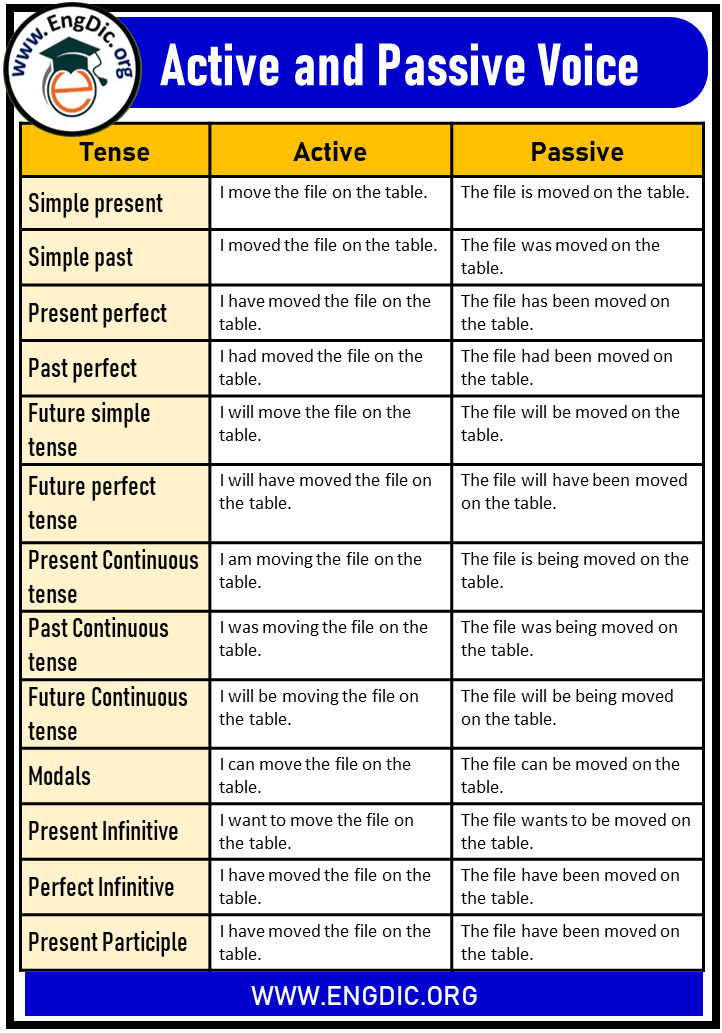
Active and Passive Voice Examples for All Tenses EngDic
Future Perfect Continuous Tense Active And Passive. Note:Keep in mind that it is not common in written English to change the active sentences from present perfect progressive, past perfect progressive, and future perfect progressive tenses into passive sentences in written English, but they could be rarely changed in spoken English.In order to help our visitors, know their use in spoken.

Using the Passive Voice with Different Tenses ESL Buzz
Present tense; Past tense; Future tense; Let's learn all 12 tenses one by one. We will start with the present tense. SIMPLE PRESENT TENSE. The Simple Present tense, also known as the Present Indefinite tense, is used to talk about actions we do repeatedly.We use this tense to talk about repeated actions, universal facts, likes, dislikes, goals, ambitions, and a few more.

Future Perfect Tense {Active to Passive Voice} YouTube
Passive Voice. I shall sell my house. My house will be sold by me. She will help you to solve the problem. You will be helped to solve the problem by him. She will submit her thesis tomorrow. Her thesis will be submitted tomorrow by her. The law will punish her for her wrongdoings. She will be punished for her wrongdoings by the law.

Future Perfect Tense Active & Passive Voice Newsman's English YouTube
1. We convert the object of the Active Voice Sentence into the subject of the Passive Voice Sentence. 2. We use the helping verb will have been/shall have been according to the subject of the Passive Voice Sentence. 3. We use the past participle form of the Verb. 4. Then we use the word "by", to show the doer. 5.
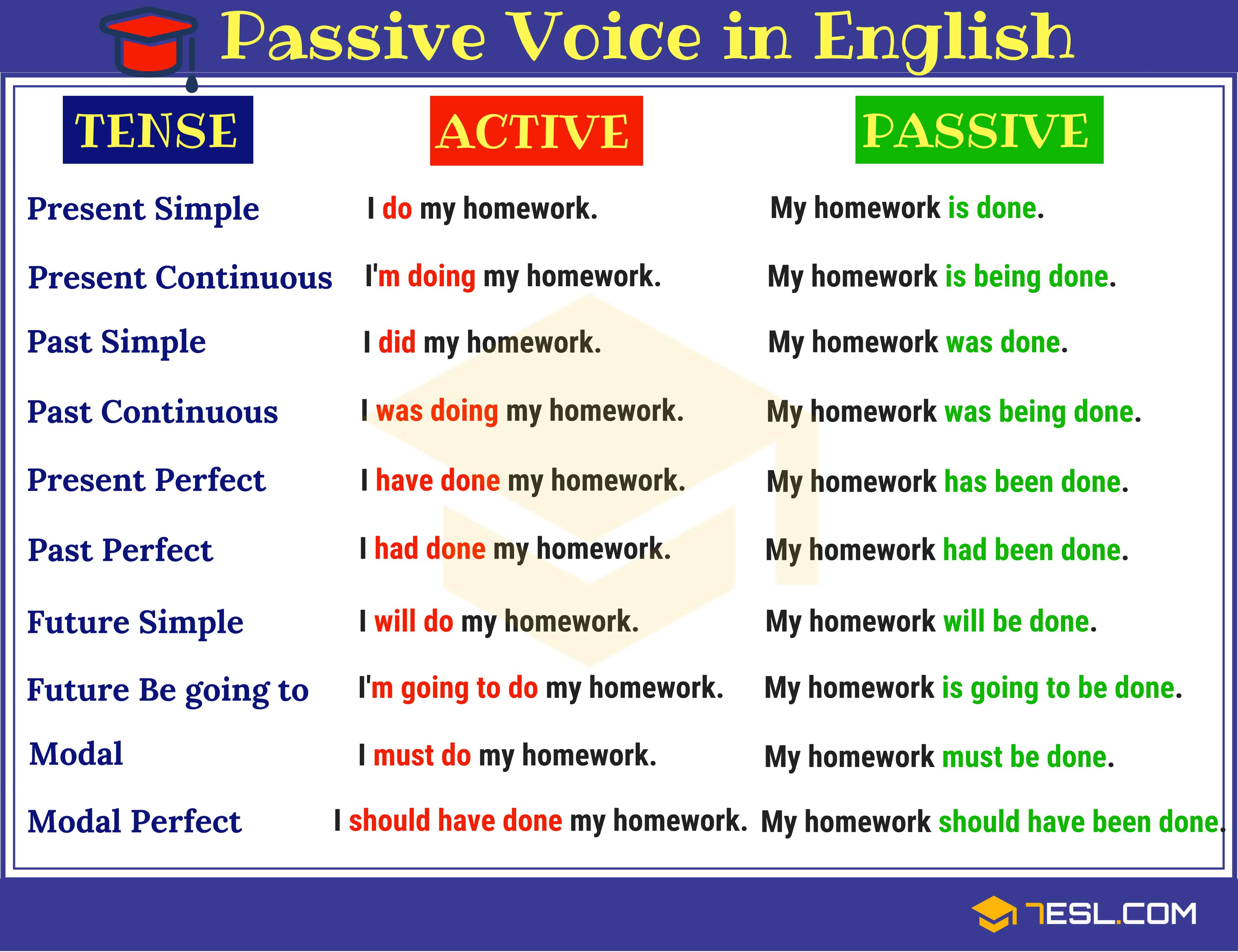
Passive Voice How to Use the Active and Passive Voice Properly • 7ESL
How to make the Passive in English We make the passive by putting the verb 'to be' into whatever tense we need and then adding the past participle. For regular verbs, we make the past participle by adding 'ed' to the infinitive. So play becomes played. Click here to learn about irregular verbs . Practise with these exercises Verbs with two objects
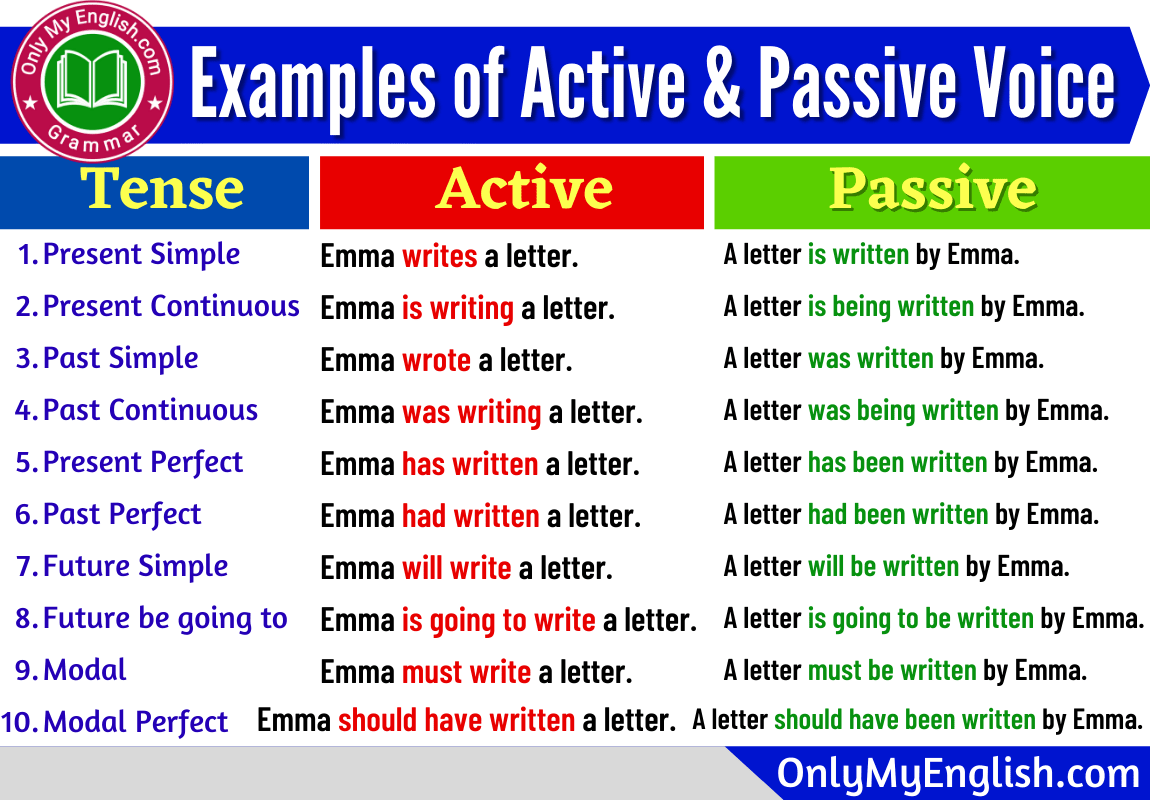
Examples of Active and Passive Voice with Answers »
We sometimes use the verb get with a past participle to form the passive: Be careful with that glass. It might get broken. Peter got hurt in a crash. We can use the indirect object as the subject of a passive verb: Active. Passive. I gave him a book for his birthday. He was given a book for his birthday.

Future Perfect Tense Detailed Expression English Study Here
1. Affirmative Sentences To form affirmative sentences in the future perfect tense to passive voice, you need to follow these rules and structure: Rules: Identify the subject, verb, and object in the active voice sentence. Convert the object of the active voice sentence into the subject of the passive voice sentence.

Changing active to passive voice in the Future Indefinite tense
Share 2 Active and Passive Voice of All Tenses The structures for both active and passive voice of all tenses, affirmatives, interrogatives and negatives are provided for you. In addition, click Active and Passive Voice Complete Rules, you might find this useful too. Active and Passive Voice of All Tenses Simple present tense Affirmatives

Active and Passive Voice Examples with Answers English Study Here
Active and Passive Voice Rules and Exercises (Future Perfect Tense) By admin | March 31, 2022 0 Comment FUTURE PERFECT TENSE Passive Voice: have/ shall have + been + 3rd form of the verb. Rule : will/shall + have + been + 1st form of the verb. Exercise-1 Directions:- Convert the following tenses into Passive Voice:- 1. Bhushan will have helped me.

Using the Passive Voice with Different Tenses ESL Buzz
The following is a summary of active and passive forms of all verb tenses. Remember that in active forms the subject of the sentence is the person or thing that does the action. In passive. Note: Not used in the passive voice. • Future Perfect Progressive Use the future perfect progressive to indicate an action projected to have been going.

Active and Passive Voice Rules Future perfect Tense English Grammar
The passive verb form in the future perfect tense is made by putting ' will / shall + have been ' before the past participle form of the verb. Active verb form: will/shall + have + past participle form of the verb Passive verb form: will/shall + have been + past participle form of the verb Exercise
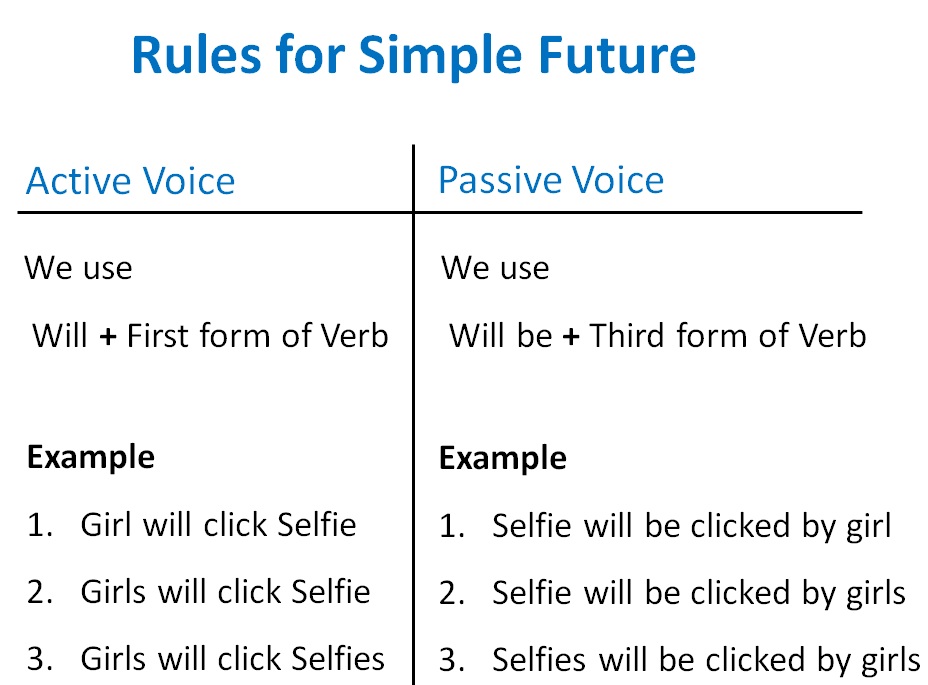
Simple Future Active Passive Voice Rules Active Voice and Passive Vo
The rules below describe future perfect tense active and passive voice. Remember the use of "be going to" is not common in future perfect and future perfect progressive tense passive sentences. In addition, click Active and Passive Voice Complete Rules, you might find this useful too. Future Perfect Tense Active and Passive Affirmatives

Future Continuous Active Passive Voice Rules Active Voice and Passiv
Future Perfect Active Passive Voice Rules - Active Voice and Passive V English Grammar Active Voice and Passive Voice Tired of ads? Future Perfect Active Passive Voice Rules Last updated at May 29, 2023 by Teachoo Tired of ads? Get Ad-free version of Teachoo for ₹ 999 ₹499 per month Tired of ads?
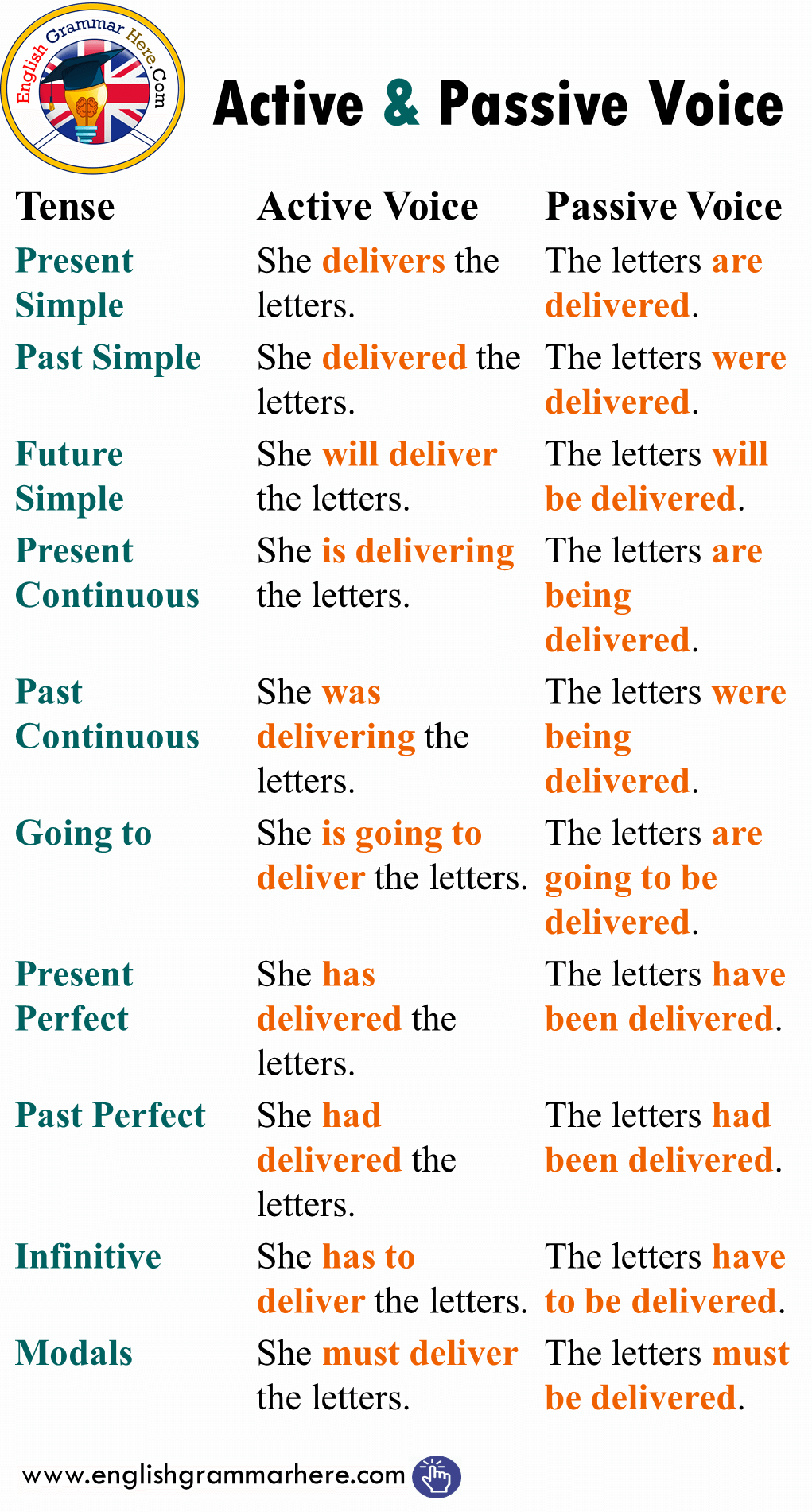
Active and Passive Voice with Tenses, Example Sentences English
Future perfect passive voice. There are several reasons why we use the passive voice in English. In these notes, we are going to focus on the future perfect in the passive voice.Generally, we use the passive voice when the focus is on the action and NOT on WHO or WHAT is performing the action.. Future perfect passive voice construction: will + have + been + past participle.

Future Perfect Active Passive Voice Rules Active Voice and Passive V
The passive voice in English grammar allows us to make the recipient of the action the focus of the sentence; the person or thing performing the action is unknown, unimportant or obvious. The passive is formed as follows: form of be + past participle. Learn the difference between the active and passive voice with Lingolia, then put your.